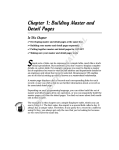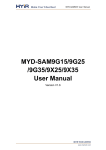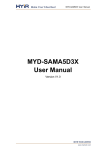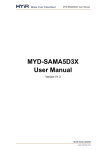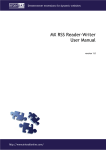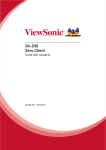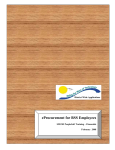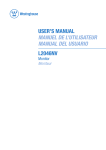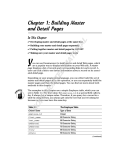Download Wiley Dreamweaver CS4 All-in-One For Dummies
Transcript
Chapter 1: Building Master
and Detail Pages
AL
In This Chapter
✓ Developing master and detail pages at the same time
RI
✓ Building your master and detail pages separately
✓ Putting together master and detail pages for ASP.NET
TE
✓ Making sure your master and detail pages work
MA
S
GH
TE
D
imple sets of data can be expressed in a simple table, much like a
traditional spreadsheet. But sometimes you don’t wish to display
complete details on a given table. For example, suppose you wish to display
a master list of employees. However, you only wish for the full address and
department details to be displayed for an employee when that record is
selected. Dreamweaver enables you to do this by setting up what is known
as a master-detail relationship.
PY
RI
You can use Dreamweaver to build master and detail Web pages, which
are a popular way to display information on your Web site. A master page
displays a list of records and corresponding links for each record. A user
can click a link to see further information about a record on its associated
detail page.
CO
Depending on your programming language, you can either build the set of
master and detail pages all in one operation, or you can separately build the
master pages and then the detail pages. You can find out more about both
methods in this chapter.
The examples in this chapter use a simple Employee table, which you can
see in Table 1-1. The first value, the empid, is a special field called a key. It
always has a unique value. Therefore, if you query for a record in a table by
using the key, you always get only the row that you’re looking for because
no two rows have the same key.
690
Building Master and Detail Pages in One Operation . . .
Table 1-1
The Employee Table
Column Name
Type of Data
empid
Integer
firstname
20 character string
lastname
20 character string
address1
25 character string
address2
25 character string
city
20 character string
state
2 character string
zip
10 character string
deptid
Integer
Building Master and Detail Pages in One
Operation (PHP, ASP, JSP, ColdFusion)
For PHP, ASP, JSP, and ColdFusion, you can build sets of master and detail
pages all in one operation. You can use the same method for all these
languages. Creating both the master and detail pages at the same time is
generally easier, but Dreamweaver gives you the flexibility of creating them
separately, too.
To create a master and detail page set for PHP, ASP, JSP, or ColdFusion,
follow these steps:
1. Create a new or open an existing dynamic page.
A blank page opens in Dreamweaver; this page becomes your master
page in the language that you selected.
2. Define a recordset for the page.
For the lowdown on creating a recordset, check out Book VIII, Chapter 1.
The recordset provides the data that’s displayed on both the master
and detail pages. Make sure that you include all the table columns that
you need to create your master page, including the unique key (the
record ID column) for each record and all the table columns that you
need to create your detail page. Typically, you show more columns on
the detail page than on the master page.
For the example in this chapter, we created an employee_records
recordset and included all the columns in the employee table (see
Table 1-1).
Building Master and Detail Pages in One Operation . . .
691
3. Save your changes to the master page.
4. Choose Insert➪Data Objects➪Master Detail Page Set to insert the
master and detail pages all in one operation.
The Insert Master-Detail Page Set dialog box appears (see Figure 1-2).
You specify the properties for the master page in the top half of this
dialog box and the properties for the detail page in the lower half.
5. From the Recordset drop-down list, select the recordset that you want
to use for the master page.
For this example, I selected employee_records.
After you select a recordset, Dreamweaver fills in the rest of the fields
with the columns from the recordset.
6. In the Master Page Fields area, select which records you want to
appear on the master page.
Click the plus (+) button to add a field and click the minus (–) button to
remove a field. In Figure 1-2, we selected the first_name and last_
name fields. These fields appear on the master page in a table format.
Typically, fewer fields appear on the master page than the detail page.
Figure 1-1:
Dreamweaver with
a recordset
defined.
Building Master and
Detail Pages
The new recordset appears in the Bindings panel, and connection code
is automatically added to the dynamic page, as shown in Figure 1-1. This
page allows a listing of employees to display on the master page.
Book IX
Chapter 1
692
Building Master and Detail Pages in One Operation . . .
Figure 1-2:
The Insert
MasterDetail Page
Set dialog
box.
7. From the Link to Detail From drop-down list, select the field in the
recordset that you want to serve as the link to the detail page.
This field is the one that a user clicks on to display details for a given
employee.
For example, I selected the last_name field to serve as the link to the
detail page for each record.
8. From the Pass Unique Key drop-down list, select which field contains
the values that you want to pass on to the detail page so it can identify
the records.
Typically, you select the key field of the table. This key field tells the
detail page which record to display for the user. For our example, we
selected the empid field.
9. Specify the number of records that you want to show at one time on
the master page.
In the example, we chose to show 10 records at a time.
10. In the Detail Page Name text box, enter a name for the detail page or
click the Browse button to select an existing file.
For the example, we specify detail.php. Dreamweaver automatically
uses this name when it creates the detail page.
11. In the Detail Page Fields area, select which records you want to
appear on the master page.
Building Master and Detail Pages in One Operation . . .
693
Click the plus (+) button and minus (–) button to change the fields that
appear on the detail page.
As you can see, Figure 1-2 shows the configuration of the Insert
Master-Detail Page Set dialog box based on the example values.
12. Click OK.
Dreamweaver creates the master and detail pages and includes dynamic
content and server behaviors in both.
The Document window contains the automatically generated objects
(a repeated region, navigation objects, record, counter, and link to the
detail page), as shown in Figure 1-3.
The detail.php is created automatically for you. You can click the
detail.php tab in the Document window to see the layout (see Figure 1-4).
13. Modify the design of the master and detail pages.
You can modify your dynamic fields just as you’d edit any other object.
Figure 1-3:
The
document
shows a
repeated
region,
navigation
objects,
record
counter, and
a link to the
detail page.
Building Master and
Detail Pages
Typically, more fields appear on the detail page than the master page.
For the example, we selected all the fields in the table.
Book IX
Chapter 1
694
Developing Master and Detail Pages Block by Block
Figure 1-4:
The detail
page is
created
automatically by
Dreamweaver.
When you finish designing the pages, you’re ready to preview your work in a
browser. See the section “Testing Your Master and Detail Pages,” later in this
chapter for details.
For ASP.NET, you need to build the master and detail pages separately (as
described in the section “Developing Master and Detail Pages for ASP.NET,”
later in this chapter). You can’t build these pages at the same time in one
operation for ASP.NET.
Developing Master and Detail Pages Block by Block
You can develop a master page block by block for PHP, ASP, JSP, and
ColdFusion. Although you usually create the master and detail pages at the
same time, you can create them block by block to have complete control
over the placement of the blocks.
Creating the master page
To create a dynamic master page, follow these steps:
1. Create a page and define a recordset.
Turn to Book VIII, Chapter 1 to find out how to define a recordset.
Developing Master and Detail Pages Block by Block
695
2. In the Document window, place the insertion point where you want
the records to appear on the page.
The Dynamic Table dialog box opens, as shown in Figure 1-5.
Figure 1-5:
The
Dynamic
Table dialog
box.
4. From the Recordset drop-down list, select the name of the recordset
that you want to appear on the master page.
5. Specify the number of records that you want to show at one time on
the master page.
In the example, we wanted to show 10 records at a time.
6. Optionally, specify border, cell padding, and cell spacing.
7. Click OK to close the dialog box.
The master table is created and added to your document.
If you don’t want users to see some of the columns on the master page,
delete the column from the table by following these steps:
1. In Design view, click anywhere on the master page.
2. Put the pointer near the top of the column so that the column’s entries
are outlined in red. Then click to select the column.
3. Click the Delete button to delete the column from the table.
Setting up links to open a detail page
After you create the master page (as the preceding section describes), you
need to create links that open the detail page and communicate which
record the user selected so that only the detail for that record displays.
To set up links to open a detail page, follow these steps:
1. Open the master page in the Document window.
Building Master and
Detail Pages
3. Choose Insert➪Data Objects➪Dynamic Data➪Dynamic Table.
Book IX
Chapter 1
696
Developing Master and Detail Pages Block by Block
2. In the table, select the placeholder for the dynamic content on which
you want to create a link.
3. In the Properties inspector, click the folder button next to the
Link field.
The Select File dialog box appears (see Figure 1-6).
4. Browse to and select the detail page.
5. Click the Parameters button to the right of the URL field.
The Parameters dialog box opens.
Figure 1-7 shows the dialog box.
6. Click the plus (+) button to add a parameter.
This parameter tells the detail page which row to display. Select the key
value column as this parameter.
7. In the Name column, enter the column name.
You can also click the Dynamic lightning bolt button and select it from
the dialog box.
Figure 1-6:
Use the
Select File
dialog box
to configure
which page
to link to
and which
parameters
to send.
Figure 1-7:
Configuring
the URL
parameter
and its
recordset.
Developing Master and Detail Pages Block by Block
697
8. Click in the Value column and then click the Dynamic (lightning bolt)
button.
9. Expand the recordset, click the key field, and then click OK.
In this case, the key field is empid.
After you click OK, the Parameters dialog box displays the new parameter and the code that places it into the page dynamically, as shown in
Figure 1-7.
10. Click OK to close the Parameters dialog box.
The URL field in the Select File dialog box is pre-populated with the new
parameter.
Each dynamic page type has different code that appears because each
programming language uses a slightly different syntax to display a URL
variable dynamically. Fortunately, because Dreamweaver is generating
the code for you, you don’t need to know the syntax differences.
11. Click Choose to close the Select File dialog box.
You return to the Document window. The name of the detail page
appears in the Link field in the Properties inspector. The placeholder for
the dynamic content is now a link.
12. Save your changes to the master page.
You now have a complete master page.
Read on to find out how to make the detail page.
Building detail pages
To create a detail page for PHP, ASP, JSP, and ColdFusion page types, follow
these steps:
1. Create a new or open an existing PHP, ASP, JSP, or ColdFusion page.
2. In the Bindings panel, click the plus (+) button and select Recordset
(Query) from the menu that appears.
The simple Recordset dialog box appears.
If you want to write your own SQL statements, click the Advanced
button to display the advanced Recordset dialog box.
3. In the Name text box, enter a name for your recordset.
You can use only letters, numbers, and underscores in the name.
Building Master and
Detail Pages
The Dynamic Data dialog box displays. This is where you select the
column from the recordset.
Book IX
Chapter 1
698
Developing Master and Detail Pages Block by Block
4. Select a database connection for obtaining the data that you want to
display.
5. Select a table name for obtaining the data that you want to display.
After you select a table name, the database columns appear in the
Columns list.
6. Select which columns should provide the record data to display.
Typically, your detail page uses more columns than your master page.
You want the recordset for your detail page to contain at least one
column (generally the id field) that matches the column that you use for
the master page.
7. Complete the Filter sections as follows:
• The first Filter field: Select the database column name that contains
values to match against the URL parameter (specified in the “Setting
up links to open a detail page” section earlier in this chapter). You
use the filter to find and display the record specified by the URL
parameter passed from the master page.
• The second Filter field: Select the equals (=) symbol, if it’s not
already selected. This requires the fields to be equal, which they
must be to display only the record that is detailed.
• The third Filter field: Select the URL parameter.
• The fourth Filter field: Enter the name of the URL parameter that
you want the master page to pass to the detail page.
The recordset (see Figure 1-8) now returns only the data for the
employee who’s been selected on the master page.
Figure 1-8:
Defining
a detail
recordset.
Developing Master and Detail Pages Block by Block
699
8. Click the Test button.
The Test Value dialog box appears.
This value represents which detail record displays. This test helps
you check that the detail page brings back the data you expect.
A table displaying data from the recordset appears.
10. Click OK.
The Test SQL Statement window closes.
11. In the Recordset dialog box, click OK.
12. To bind the columns in the recordset to the detail page, select the
columns in the Bindings panel and drag those columns onto the
detail page.
Your detail page can now process requests from the master page. Figure
1-9 shows the Document window after adding fields from the recordset.
See the section “Testing Your Master and Detail Pages,” later in this chapter,
to find out how to preview your master and detail pages in a browser.
Figure 1-9:
The
Document
window
after
dragging
several
fields
from the
recordset
onto it.
Building Master and
Detail Pages
9. Enter a value in the Test Value field and click OK.
Book IX
Chapter 1
700
Developing Master and Detail Pages for ASP.NET
Developing Master and Detail Pages for ASP.NET
For ASP.NET, you can use the DataSet Web control to specify table columns
and the DataGrid Web control to list the database records to display on the
master page. The Web controls provide an easy way to display database
data with controls for paging between multiple pages of records.
You need to define a database connection for the site before you create the
master page. See Book VII for details.
Creating a master page
To create an ASP.NET master page, follow these steps:
1. Create a new or open an existing ASP.NET page in Dreamweaver.
2. In the Bindings panel, click the plus (+) button and select DataSet
(Query) from the menu that appears.
The DataSet dialog box appears.
3. Complete the DataSet dialog box and then click OK.
Make sure to include all table columns that you need to create
your master page, including the unique key (Record ID column) for
each record.
A dataset is essentially the same thing as a recordset; see Book VIII,
Chapter 1 for more information on recordsets.
The new dataset appears in the Binding panel.
4. In the Server Behaviors panel, click the plus (+) button and select
DataGrid from the menu that appears.
The DataGrid dialog box opens.
5. Select the dataset source from the DataSet drop-down list and
click OK.
You can leave the default column type as Simple Data Field.
Creating links that open the detail page
After you create the ASP.NET master page (as described in the preceding
section), you need to create links that open the detail page and communicate which record the user selected. To open an ASP.NET detail page and
display the specified record, follow these steps:
1. Open the master page in the Document window.
Developing Master and Detail Pages for ASP.NET
701
2. In the Server Behaviors panel, double-click DataGrid.
The DataGrid dialog box appears.
link to the detail page.
You can use any field that identifies the record for expanding the detail
of the record.
4. Click the Change Column Type button.
5. Select Hyperlink from the pop-up menu.
The Hyperlink Column dialog box appears.
6. In the Hyperlink Text section, specify the text that you want to display
in the hyperlink column.
Here are your choices:
• Static Text: Select this radio button if you want to use a generic
description for this column. Enter text for the link, such as Details.
• Data Field: Select this radio button if you want to add text for a link
based on a hyperlink column. Then from the drop-down list, select a
data field in your dataset. In the example, we selected the last_
name column.
• Format String: This field is automatically generated and shows the
format of the URL text.
7. In the Linked Page section, specify the URL for the hyperlink
column text.
Here are your choices:
• Static Text: Select this radio button if you want to use a generic link
for this column. Enter the URL for the link, such as Details.aspx.
• Data Field: Select this radio button if you want to add a link for data
displayed in the hyperlink column. Then from the drop-down list,
select a data field in your dataset. In the example, we selected the
first_name column.
• Format String: This field is automatically generated and shows the
format of the URL link.
The URL opens the detail page and uniquely identifies the record to
display on the detail page.
8. In the Linked Page section, click the Browse button next to the Format
String box.
Building Master and
Detail Pages
3. In the Columns list, select the column that you want to serve as the
Book IX
Chapter 1
702
Testing Your Master and Detail Pages
9. Locate and select which detail page you want to display.
Note the following when selecting your link page:
• When you select a detail page, Dreamweaver adds information to the
URL that specifies a parameter to use to identify the record.
• Dreamweaver automatically names this parameter based on your
database field name, but you can change the name to something else
if you want to.
• In any case, be sure to note the name of this URL parameter because
you need that name when you create the detail page (which you can
read about in the following section, “Creating a detail page”).
• Dreamweaver uses a {0} placeholder to indicate where it places the
value of the unique identifier when someone accesses the page.
10. Click OK to close the Hyperlink Column dialog box.
11. Click OK.
The DataGrid dialog box closes. The DataGrid on your page is updated.
Creating a detail page
After you create a master page for ASP.NET (as described in the two
previous sections), you need to create a detail page to display the record.
To do so, you need to define a dataset for the record and bind its columns
to the detail page.
When creating the detail page, you need to know the database column name
that you want to reference and the URL parameter that the master page uses
to find and display that column’s record on the detail page. If you don’t
remember the URL parameter name, open the master page, go to the
Bindings panel, and look under the DataSet listing.
To create an ASP.NET detail page, create a new ASP.NET page in
Dreamweaver and follow Steps 2 through 12 in the earlier section, “Building
detail pages.” Note that although the earlier steps show you how to fill out
the Recordset dialog box, the steps are the same for the DataSet dialog box,
which you fill out when creating an ASP.NET detail page.
Testing Your Master and Detail Pages
After you create a master and detail page set, you need to test those pages.
Follow these steps to preview the pages in a browser:
Testing Your Master and Detail Pages
703
site, click OK.
Your browser launches with your master page (see Figure 1-10).
4. Click a hyperlink to view the associated detail page for that record.
In the employee example, the linked field is the employee’s last name.
When you click a link, the browser page changes to expand the record
and display the detail page.
Be sure that both your master page and detail page transfer to the testing
server. If not, when you click a link in the master page, you get a Page not
found error message.
Figure 1-10:
The browser
displays the
master page
that uses
the data
from the
databases.
Book IX
Chapter 1
Building Master and
Detail Pages
1. Open the master page.
2. Choose File➪Preview in Browser➪Name of Browser.
3. When Dreamweaver asks you if it’s okay to copy the file to the testing
704
Book IX: Developing Applications Rapidly
















